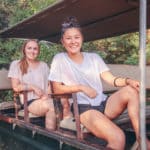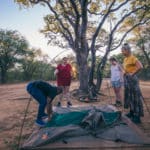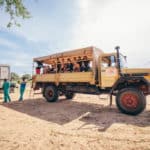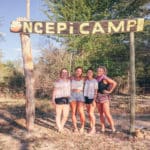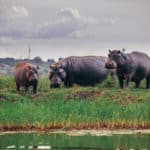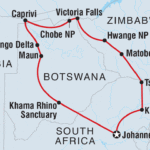Real Southern Africa
Four countries, eight national parks, 17 days, hundreds of animals, countless birds and a new group of lifelong friends all make this one unforgettable journey through the best of Southern Africa. Track rhinos at sunset in Zimbabwe, search for wildlife in Kruger National Park, laze in the lagoons of the Okavango Delta in Botswana, and learn about ongoing rhino conservation in Zimbabwe. This overland camping trip brings you everything wild and wonderful about Southern Africa plus a crew of good pals to take it all in with.
17 days, from
$2,550
per person
GROUP SIZE
ACTIVITY LEVEL
Details
Countries Visited:
Botswana
Namibia
South Africa
Zimbabwe
Accommodation: Hotel (1 night), Camping (with facilities) (13 nights), Camping (with basic facilities) (2 nights)
Transportation: Overland vehicle , Mokoro , 4WD safari vehicle
Included Meals:
- 16 breakfasts
- 3 lunches
- 13 dinners
Group size: Minimum 1, Max 22
Minimum Age: 18
Ever helped save a Rhino? Well you can answer ‘yes, thanks’ to that once you’ve been to Botswana’s Khama Rhino Sanctuary
Try and tell the difference between your buddy’s snores and the sound of wild hippos while camping in the heart of the Okavango wilderness
There's nothing more relaxing than feeling the African sun on your face as you lie back in a mokoro, eyes closed while your expert poler propels you through the Okavango Delta
Elephants might never forget, but you’ll get the unforgettable experience of cruising down the river in Chobe National Park, home of the world's highest concentration of African elephants.
Victoria Falls is made for thrill seekers and adrenaline junkies. Peer over the edge of this crazy cascade, then stay on for adventures on land and in the sky.
Pay the famous elephants and lions of Hwange National Park a visit from an open-air 4x4 vehicle.
What is the sound of a roaring lion if not a sweet soothing lullaby? You'll be camping right in the grounds of Kruger National Park (OMG), so you be the judge.
Forget the Grand Canyon – Blyde River Canyon's is gigantic AND lush and green, pure photo-op gold.
Itinerary
Sawubona! Welcome to South Africa. Touch down in Jo’burg (as the locals like to call it). You’ve got the whole day free to explore the capital city (depending on when you get here of course) before you join up with your crew at a 6 pm welcome meeting tonight. If you do find yourself with time to kill, perhaps head to the culturally rich areas of Newtown, Braamfontein or Maboneng. The eye-opening Apartheid Museum is also well worth your time.
See ya South Africa – cross the border into Botswana and travel toward the Khama Rhino Sanctuary (approximately 8–10 hours). It sits on the Kalahari Desert, and is an old hunting area transformed into a conservation project. It now protects what’s left of Botswana's black and white rhino populations, but there are plenty of other beasties hanging around too – zebras, giraffes, leopards, ostriches and wildebeest, all of which chill out around many natural waterholes. Not only do you get to check out awesome animals here, but you’ll also be benefitting local communities and helping protect the white rhino. When the sun begins to set, hop in a jeep to see the rhinos at their most active. About 35 rhinos roam around this 400ha community-based reserve. Don't forget your binoculars, or you'll be getting them confused with big rocks. At your camp there will be the option to upgrade to a room for an additional cost (subject to availability).
Get up real early, jump aboard the truck and head to Maun (approximately 7-8 hours). Catch up on your beauty sleep or kick off the most epic game of I Spy you've ever played. This journey also includes a free massage service (the road might get a little bumpy). In Maun there’s the chance to stock up on any supplies you might need for the journey ahead – maybe hats, sunscreen and scarves (for the morning chill and the afternoon sun). Maun’s the gateway to one of the world's most renowned and complex ecosystems, the Okavango Delta. This is a one-of-a-kind kinda place – a 16,000 square kilometre maze of wetlands made up of meandering waterways, green islands, lush plains and loads of wildlife. You might see hippos, crocodiles, elephants and big cats. But honestly it's not really the animals that are the main attraction – it's the incredibly diverse ecosystem and atmospheric waterscapes. Tonight you'll stay on the outskirts of Maun at a simple campsite with shared facilities, wi-fi and optional upgrades.
Make your way to the north-western part of the Okavango Delta, close to the Pan Handle. The drive is a not so whopping 300 kilometres and will take you about 6 hours. Now’s the time to find out everything about your fellow travellers – you’ll be old mates by the end of it. Leave the truck at some secure parking and take a 4x4 transfer for the last 12 kilometres. Your final destination for the next two nights sits on the edge of the Guma Lagoon area. Set up camp and relax on the edge of the lagoon for the rest of the afternoon, then fall asleep to the sounds of the African bush at night – is that noise a hippo or your mate snoring?
Today you get to paddle the mighty Okavango Delta. There's nothing more relaxing than feeling the African sun on your face as you lie back in a mokoro (traditional dugout canoe), while your expert poler propels you down calm waters through papyrus and reed beds to lily covered lagoons and islands. Watch out for elephants, lechwe, warthogs, sitatunga and other plains game in the open. Stop at one of the islands for a picnic lunch before returning to camp in the late afternoon. Take a swim or ask you leader about taking a walk around the area. If you are interested in the culinary side of Southern Africa, feel free to join your cook for an in-depth cooking class while they prepare tonight's meal.
This morning it’s back in the 4x4s and a drive back to the truck. Then you’ll make your way to the border to cross into Namibia. The drive is approximately 150km and will take about 4 hours, including the border crossing. You’ll drive through the Mahango Game Reserve on the Namibia side on the way to the camp for the night. The camp is on the banks of the Kovango river, within the Caprivi Game Park strip of Namibia. This strip of land is sandwiched between Botswana and Angola, and connects with Zambia and Zimbabwe at its end. In the afternoon you’ll head out on a guided excursion through the villages of the Hambukushu and Xwe Bushmen tribes, exploring local life up close. Look out for some Botswana Baskets – some say they’re the finest craft works in Africa!
Today is another drive of approximately 300 kilometres and about 5 hours, before reaching your next camp on the banks of the Kwando River along the border with Botswana. After settling in you can either relax or jump on one of the optional activities available here, such as a late afternoon boat trip, or a game drive in Mudumu Game Park (look out for buffalo, elephants, loads of antelope species, and zebra). You could also take a village tour, chill with another mokoro ride, or join in on a fishing trip – the locals will give you the heads up on the best spot. Just have a chat with your leader and they’ll let you know what’s what.
Zip over to the edge of the Chobe National Park, where you’ll spend the night. The approximately 5-hour drive takes you further through the Caprivi Strip and back into Botswana. Cruise into Chobe Park on the only stretch of tarred road before reaching your camp. Set up then choose whether you’d like to head out on an optional late afternoon boat cruise on the Chobe River. The Chobe River has a huge range of wildlife, all packed into a tiny area, making it unlike anywhere else in the world. If you choose to cruise you’ll get up close and personal with hippos, buffalo, crocodiles and a mind-boggling array of water birds. But elephants are the big stars here, and don't they know it. Parading around in big groups, showing off their cute babies and tearing down enormous trees limb by limb. While the cruise isn’t included in your trip price, we think it’s worth the extra cost. If you’d prefer, you can kick back at camp with a book and relax.
This morning there'll be time to join an optional game drive in the Chobe National Park. Then it’s onto Victoria Falls this afternoon (approximately 2–3 hours). You will cross the border into Zimbabwe and arrive in the early afternoon. This afternoon you’ve gotta make your way to Vic Falls itself. The entrance fee is a bit steep, but for Beyonce of waterfalls it’s well worth it, so make sure you’re cashed up. The sound of 19 million cubic feet of water throwing itself over a mile-long edge every minute will be music to your ears. It looks pretty sweet too. There will be a meeting at 6 pm to welcome any new travellers joining you on the next stage of your adventure.
Guess what? You’re at the edge of the greatest curtain of falling water in the world. After a leader-led orientation walk of the town, enjoy a day of free time to take up one of many activities on offer in the area including a flying fox, helicopter flight, gorge swing, or even a white-water rafting experience! There are many ways to take in the thundering sight and sound of the falls. These staggering cascades are about a mile wide, falling 108 metres into a narrow gorge below. In the wet season, the spray rises high and the falls become a torrent; in the dry season, the lack of spray gives way to a nice view of the little islets in the river below. Meet up in the afternoon for a local brewery tour and tasting in town and get to know your new travel pals. Then perhaps kick on with an optional sunset cruise down the Zambezi River .
Leave Victoria Falls behind and head to Hwange National Park (approximately 5 hours, depending on traffic). En route, stop via the Victoria Falls Wildlife Trust – one of the Intrepid Foundation’s projects - where you can learn about the rescue and rehabilitation of wildlife, human-wildlife conflict and their role in anti-poaching. There may also be a chance to meet any rescued or orphaned wildlife currently in their care. Afterwards, explore the stunning arena of Hwange in an open 4x4 vehicle. This national park became the royal hunting grounds of the Ndebele warrior-king Mzilikazi in the early 19th century and was set aside as a national park in 1929. Today, Hwange boasts a massive selection of wildlife, with over 100 species of mammals and nearly 400 bird species. But it's the elephants this place is famous for – here you'll find one of the largest elephant populations in Africa.
Make tracks for Matobos with a short detour through Bulawayo, checking out its cool colonial buildings, before heading to your camp for the next two nights. Home to a large population of black and white rhinoceros that can be tracked on foot, Matobo National Park is also the site of the grave of Cecil John Rhodes, the founder of Rhodesia and the De Beers diamond company. The Matobos area has great spiritual and cultural significance to the local people and there are many sites within the park where important ceremonies still take place. For those interested in the culinary side of southern African food, tonight your cook can provide an in-depth cooking class while you help prepare this evening’s delicious meal.
Good morning from mighty Matobos. You’re free to do as you please, but what is highly recommended is heading to Matobo Hills and spending the day tracking rhinos and other game animals with the help of your guide on an optional tour. The park is home to so much wildlife, including klipspringers, leopards, warthogs and springhares. Along the way, learn about the flora in the area. After your tour lunch, head to another region of the park to find old bushman paintings, see rock formations and learn some history of the area. Then it's off to nearby African villages to meet some of the local community. It’s definitely a day you won’t want to miss.
Up early, today will be a long day with a very busy border post – the only direct border crossing between Zimbabwe and South Africa. The drive is approximately 400km long, but it can take us anything between 6 and 8 hours to reach our destination. Today’s destination is the Mapungubwe National Park in South Africa. This park is set hard against the northern border of South Africa, joining Zimbabwe and Botswana. It is an open, expansive savannah landscape at the intersection of the Limpopo and Shashe rivers. Sip sundowners overlooking the rivers or visit Mpungubwe Hill, where a far developed African civilisation prospered in the 13th century. The Interpretation Centre is the ideal place to catch up on all of this.
After breakfast, set off for renowned Kruger National Park. This world-famous park is known for the Big Five game of Africa – lion, elephant, buffalo, leopard and rhino. On top of that, it's home to some 336 kinds of trees, 49 fish species and over 500 species of bird. See how many of these you can spot on a game drive in your overland vehicle. You cover over 300km, but taking all day, you’ll be sure to spend time staking out the locals. Continue from your safari to your overnight camp, where there's the option of a further game drive – this time at night. You never know what’s going to come out and play on your safari after dark!
Wake up early for a light breakfast of coffee and rusks before embarking on a full-day game drive in the truck. Today is another full day in Kruger, heading down to the central part of the park towards your last campsite. Stop at some of the designated picnic spots for a bite to eat en route to camp. Depending on the season, you might catch a saddle-billed stork with its colourful red beak, or maybe a blue waxbill. In the afternoon when it's warm, take some time out to chill. This evening there will be another optional night drive to spot nocturnal animals and perhaps even a predator or two.
Venture out for one last safari adventure this morning and soak up all Kruger has to offer. Keep your eyes peeled, ‘cause you never know what will pop out from behind the shrubs! Continue back to Johannesburg (approximately 9–10 hours). This trip finishes on arrival in Johannesburg at a designated hotel drop-off point.

